Athermal ω Phase and Lattice Modulation in Binary Zr-Nb Alloys
Abstract
:1. Introduction
2. Materials and Methods
3. Results
3.1. Electrical Resistivity Measurements
3.2. TEM Observations
4. Discussion
5. Conclusions
Author Contributions
Funding
Institutional Review Board Statement
Informed Consent Statement
Data Availability Statement
Conflicts of Interest
References
- Olsen, O.E. Practical body MRI—A paediatric perspective. Eur. J. Radiol. 2008, 68, 299–308. [Google Scholar] [CrossRef] [PubMed]
- Olsrud, J.; Lätt, J.; Brockstedt, S.; Romner, B.; Björkman-Burtscher, I.M. Magnetic resonance imaging artifacts caused by aneurysm clips and shunt valves: Dependence on field strength (1.5 and 3 T) and imaging parameters. J Magn. Reson. Imag. 2005, 22, 433–437. [Google Scholar] [CrossRef]
- New, P.F.; Rosen, B.R.; Brady, T.J.; Buonanno, F.S.; Kistler, J.P.; Burt, C.T.; Hinshaw, W.S.; Newhouse, J.H.; Pohost, G.M.; Taveras, J.M. Potential hazards and artifacts of ferromagnetic and nonferromagnetic surgical and dental materials and devices in nuclear magnetic resonance imaging. Radiology 1983, 147, 139–148. [Google Scholar] [CrossRef] [PubMed]
- Thomsen, P.; Larsson, C.; Ericson, L.E.; Sennerby, L.; Lausmaa, J.; Kasemo, B. Structure of the interface between rabbit cortical bone and implants of gold, zirconium and titanium. J. Mater. Sci. Mater. Med. 1997, 8, 653–665. [Google Scholar] [CrossRef] [PubMed]
- Eisenbarth, E.; Velten, D.; Müller, M.; Thull, R.; Breme, J. Biocompatibility of beta-stabilizing elements of titanium alloys. Biomaterials 2004, 25, 5705–5713. [Google Scholar] [CrossRef] [PubMed]
- Yamamoto, A.; Honma, R.; Sumita, M. Cytotoxicity evaluation of 43 metal salts using murine fibroblasts and osteoblastic cells. J. Biomed. Mater. Res. 1998, 39, 331–340. [Google Scholar] [CrossRef]
- Zhou, F.Y.; Wang, B.L.; Qiu, K.J.; Lin, W.J.; Li, L.; Wang, Y.B.; Nie, F.L.; Zheng, Y.F. Microstructure, corrosion behavior and cytotoxicity of Zr-Nb alloys for biomedical application. Mater. Sci. Eng. C 2012, 32, 851–857. [Google Scholar] [CrossRef]
- Nomura, N.; Tanaka, Y.; Kondo, R.; Doi, H.; Tsutsumi, Y.; Hanawa, T. Effect of phase constitution of Zr-Nb alloys on their magnetic susceptibilities. Mater. Trans. 2009, 50, 2466–2472. [Google Scholar] [CrossRef] [Green Version]
- Kondo, R.; Nomura, N.; Tsutsumi, Y.; Doi, H.; Hanawa, T. Microstructure and mechanical properties of as-cast Zr-Nb alloys. Acta Biomater. 2011, 7, 4278–4284. [Google Scholar] [CrossRef]
- Xia, H.; Parthasarathy, G.; Luo, H.; Vohra, Y.K.; Ruoff, A.L. Crystal structures of group IVa metals at ultrahigh pressures. Phys. Rev. B Condens. Matter 1990, 42, 6736–6738. [Google Scholar] [CrossRef]
- Xia, H.; Duclos, S.J.; Ruoff, A.L.; Vohra, Y.K. New high-pressure phase transition in zirconium metal. Phys. Rev. Lett. 1990, 64, 204–207. [Google Scholar] [CrossRef]
- Sikka, S.K.; Vohra, Y.K.; Chidambaram, R. Omega phase in materials. Prog. Mater. Sci. 1982, 27, 245–310. [Google Scholar] [CrossRef]
- Silcock, J.M. An X-ray examination of the ω phase in TiV, TiMo and TiCr alloys. Acta Metall. 1958, 6, 481–493. [Google Scholar] [CrossRef]
- Hatt, B.A.; Roberts, J.A. The ω-phase in zirconium base alloys. Acta Metall. 1960, 8, 575–584. [Google Scholar] [CrossRef]
- De Fontaine, D.; Paton, N.E.; Williams, J.C. The omega phase transformation in titanium alloys as an example of displacement controlled reactions. Acta Metall. 1971, 19, 1153–1162. [Google Scholar] [CrossRef]
- Sass, S.L. The ω phase in a Zr-25 at.% Ti alloy. Acta Mater. 1969, 17, 813–820. [Google Scholar] [CrossRef]
- Benites, G.M.; Guillermet, F.; Cuello, G.J.; Campo, J. Structural properties of metastable phases in Zr-Nb alloys: I. Neutron diffraction study and analysis of lattice parameter. J. Alloys Comp. 2000, 299, 183–188. [Google Scholar] [CrossRef]
- Nomura, N.; Oya, K.; Tanaka, Y.; Kondo, R.; Doi, H.; Tsutsumi, Y.; Hanawa, T. Microstructure and magnetic susceptibility of as-cast Zr-Mo alloys. Acta Biomater. 2010, 6, 1033–1038. [Google Scholar]
- Okunishi, E.; Kawai, T.; Mitsuhara, M.; Farjami, S.; Itakura, M.; Hara, T.; Nishida, M. HAADF-STEM studies of athermal and isothermal ω-phase in β-Zr alloy. J. Alloy. Comp. 2013, 577, S713–S716. [Google Scholar] [CrossRef]
- Kondo, R.; Tsutsumi, Y.; Doi, H.; Nomura, N.; Hanawa, T. Effect of phase constitution on magnetic susceptibility and mechanical properties of Zr-rich Zr-Mo alloys. Acta Biomater. 2011, 7, 4259–4266. [Google Scholar]
- Dey, G.K.; Tewari, R.; Jyoti, G.; Gupta, S.C.; Joshi, K.D.; Sikka, S.K. Formation of a shock deformation induced ω phase in Zr 20 Nb alloy. Acta Mater. 2004, 53, 5243–5254. [Google Scholar] [CrossRef]
- Lee, S.H.; Todai, M.; Tane, M.; Hagihara, K.; Nakajima, H.; Nakano, T. Biocompatible low Young’s modulus achieved by strong crystallographic elastic anisotropy in Ti-15Mo-5Zr-3Al alloy single crystal. J. Mech. Behav. Biomed. Mater. 2012, 14, 48–54. [Google Scholar] [CrossRef] [PubMed]
- Tane, M.; Akita, S.; Nakano, T.; Hagihara, K.; Umakoshi, Y.; Niinomi, M.; Nakajima, H. Peculiar elastic behavior of Ti-Nb-Ta-Zr single crystals. Acta Mater. 2008, 56, 2856–2863. [Google Scholar] [CrossRef]
- Tane, M.; Akita, S.; Nakano, T.; Hagihara, K.; Umakoshi, Y.; Niinomi, M.; Mori, H.; Nakajima, H. Low Young’s modulus of Ti-Nb-Ta-Zr alloys caused by softening in shear modului c′ and c44 near lower limit of body-centered cubic phase stability. Acta Mater. 2010, 58, 6790–6798. [Google Scholar] [CrossRef]
- Wang, P.; Todai, M.; Nakano, T. Beta titanium single crystal with bone-like elastic modulus and large crystallographic elastic anisotropy. J. Alloy. Comp. 2019, 782, 667–671. [Google Scholar] [CrossRef]
- Wang, P.; Todai, M.; Nakano, T. ω-phase transformation and lattice modulation in biomedical β-phase Ti-Nb-Al alloys. J. Alloy. Comp. 2018, 766, 511–516. [Google Scholar] [CrossRef]
- Wang, P.; Todai, M.; Nakano, T. β phase instability in Binary Ti-xNb Biomaterial single crystal. Mater. Trans. 2013, 54, 156–160. [Google Scholar]
- Ames, S.L.; McQuillan, A.D. The resistivity-temperature-concentration relationships in the system niobium-titanium. Acta Metall. 1954, 2, 831–836. [Google Scholar] [CrossRef]
- Ikeda, M.; Komatsu, S.; Sugimoto, T.; Kamei, K. Temperature range of formation of athermal ω phase in quenched β Ti-Nb alloys. J. Jap. Ins. Metals. 1988, 52, 1206–1211. [Google Scholar] [CrossRef] [Green Version]
- Ho, J.C.; Collings, E.W. Anomalous electrical resistivity in titanium-molybdenum alloys. Phys. Rev. B 1972, 6, 3727–3738. [Google Scholar] [CrossRef]
- Todai, M.; Fukuda, T.; Kakeshita, T. Relation between negative temperature coefficient in electrical resistivity and athermal ω phase Ti-xNb (26 ≤ x ≤ 29 at.%) alloys. J. Alloys Compd. 2013, 577, S431–S434. [Google Scholar] [CrossRef]
- Kuan, T.S.; Sass, S.L. The direct imaging of a linear defect using diffuse scattering in Zr-Nb b.c.c. solid solutions. Philos. Mag. 1977, 36, 1473–1498. [Google Scholar] [CrossRef]
- Todai, M.; Fukuda, T.; Kakeshita, T. Temperature dependence of diffuse satellites in Ti–(50−x)Pd–xFe (14 ≤ x ≤ 20 (at.%)) alloys. J. Alloys Compd. 2014, 615, 1047–1051. [Google Scholar] [CrossRef]
- Todai, M.; Fukuda, T.; Kakeshita, T. Direction of atom displacement in incommensurate state of Ti–32Pd–18Fe shape memory alloy. Mater. Lett. 2013, 108, 293–296. [Google Scholar] [CrossRef]
- Tahara, M.; Kim, H.Y.; Inamura, T.; Hosoda, H.; Miyazaki, S. Lattice modulation and superelasticity in oxygen-added β-Ti alloys. Acta Mater. 2011, 59, 6208–6218. [Google Scholar] [CrossRef]
- Noyama, Y.; Miura, T.; Ishimoto, T.; Itaya, T.; Niinomi, M.; Nakano, T. Bone Loss and Reduced Bone Quality of the Human Femur after Total Hip Arthroplasty under Stress-Shielding Effects by Titanium-Based Implant. Mater. Trans. 2012, 53, 565–570. [Google Scholar] [CrossRef] [Green Version]
- Nakano, T.; Kaibara, K.; Ishimoto, T.; Tabata, Y.; Umakoshi, Y. Biological apatite (BAp) crystallographic orientation and texture as a new index for assessing the microstructure and function of bone regenerated by tissue engineering. Bone 2012, 51, 741–747. [Google Scholar] [CrossRef]
- Matsugaki, A.; Aramoto, G.; Nakano, T. The alignment of MC3T3-E1 osteoblasts on steps of slip traces introduced by dislocation motion. Biomaterials 2012, 33, 7327–7335. [Google Scholar] [CrossRef]
- Ishimoto, T.; Ozasa, R.; Nakano, K.; Weinmann, M.; Schnitter, C.; Stenzel, M.; Matsugaki, A.; Nagase, T.; Matsuzaka, T.; Todai, M.; et al. Development of TiNbTaZrMo bio-high entropy alloy (BioHEA) super-solid solution by selective laser melting, and its improved mechanical property and biocompatibility. Scr. Mater. 2021, 194, 113658. [Google Scholar] [CrossRef]
- Ishimoto, T.; Hagihara, K.; Hisamoto, K.; Sun, S.H.; Naknao, T. Crystallographic texture control of beta-type Ti–15Mo–5Zr–3Al alloy by selective laser melting for the development of novel implants with a biocompatible low Young’s modulus. Scr. Mater. 2021, 132, 34–38. [Google Scholar] [CrossRef]
- Gokcekaya, O.; Hayashi, N.; Ishimoto, T.; Ueda, K.; Narushima, T.; Nakano, T. Crystallographic orientation control of pure chromium via laser powder bed fusion and improved high temperature oxidation resistance. Addit. Manuf. 2020, 36, 101624. [Google Scholar] [CrossRef]
- Nagase, T.; Hori, T.; Todai, M.; Sun, S.H.; Nakano, T. Additive manufacturing of dense components in beta-titanium alloys with crystallographic texture from a mixture of pure metallic element powders. Mater. Des. 2019, 173, 107771. [Google Scholar] [CrossRef]
- Todai, M.; Nakano, T.; Liu, T.; Yasuda, H.Y.; Hagihara, K.; Cho, K.; Ueda, M.; Takeyama, M. Effect of building direction on the microstructure and tensile properties of Ti-48Al-2Cr-2Nb alloy additively manufactured by electron beam melting. Addit. Manuf. 2017, 13, 61–70. [Google Scholar] [CrossRef] [Green Version]
- Nomura, N.; Kawasaki, A. Development of low magnetic zirconium-based alloys and the additive manufactured builds for biomedical applications. J. Jpn. Soc. Pow. Pow. Metall. 2021, 68, 431–435. [Google Scholar] [CrossRef]
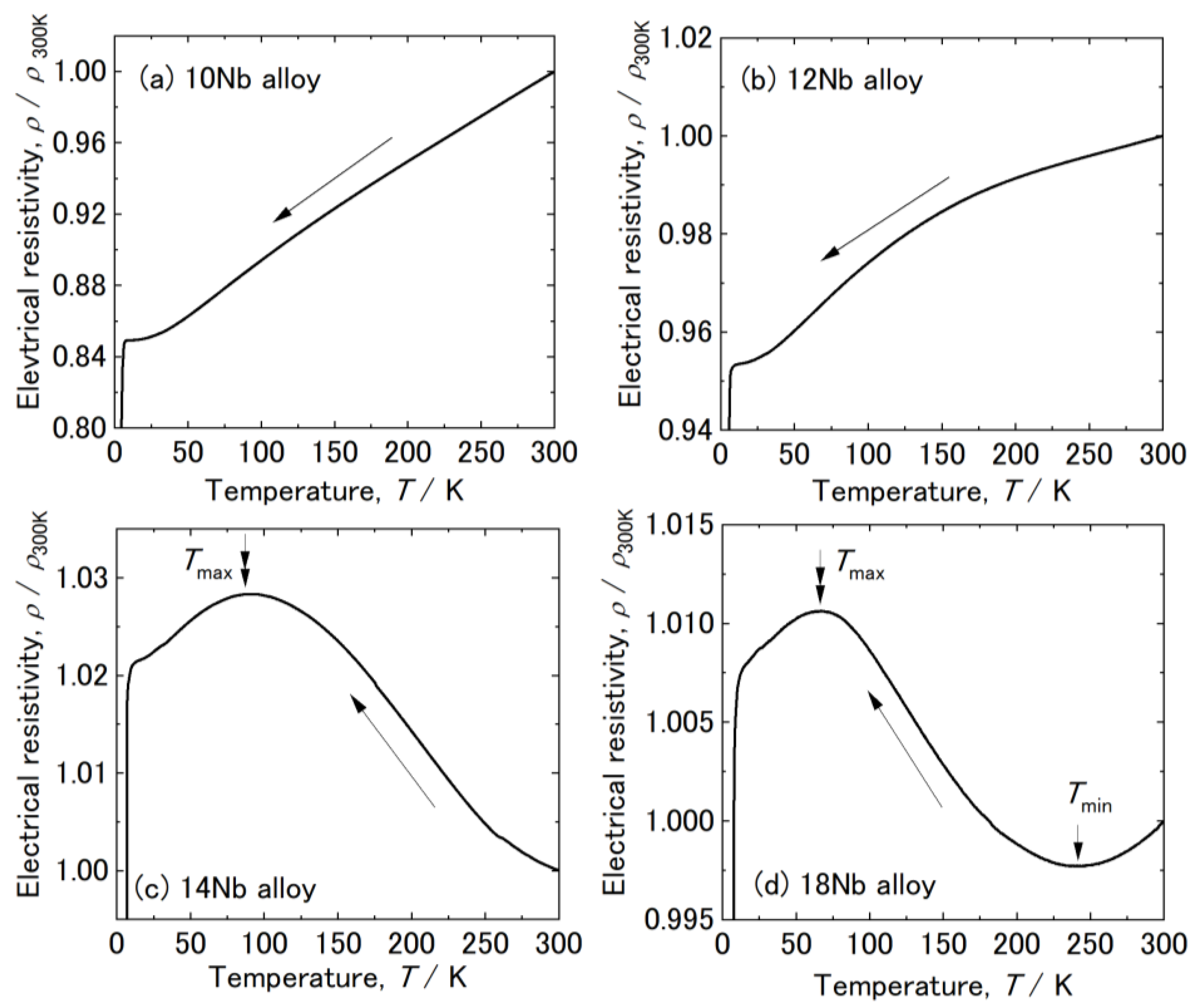
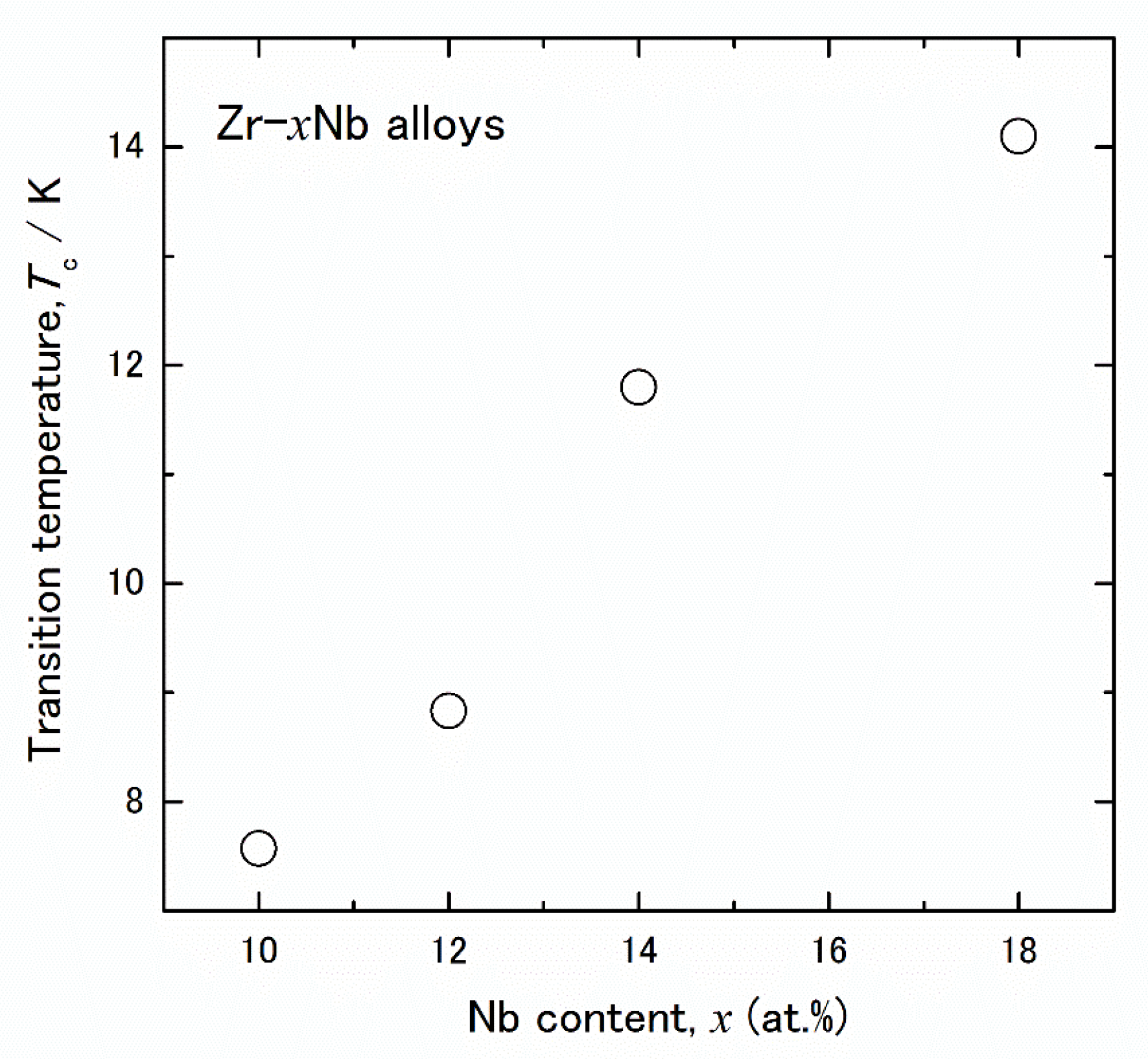

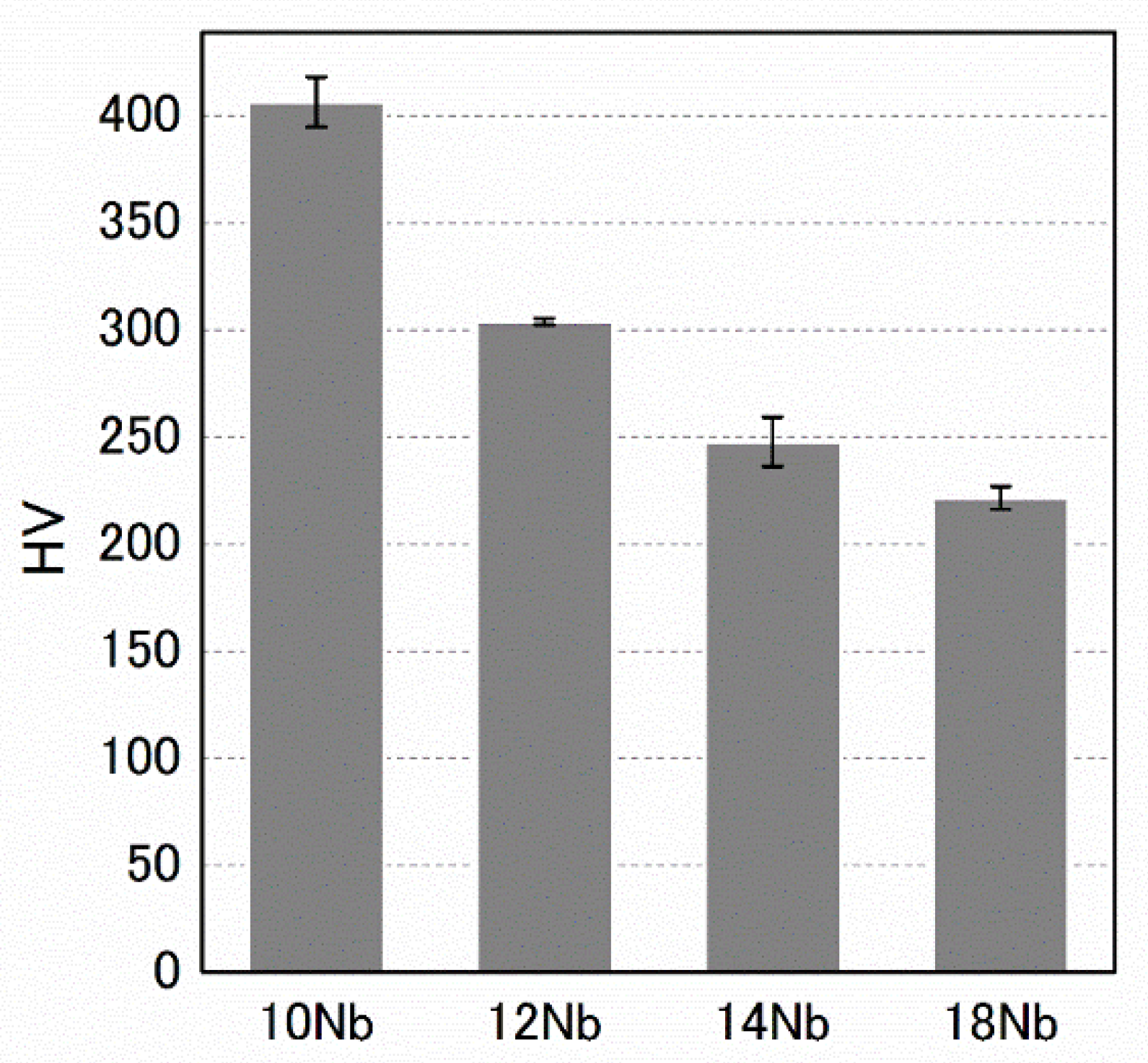
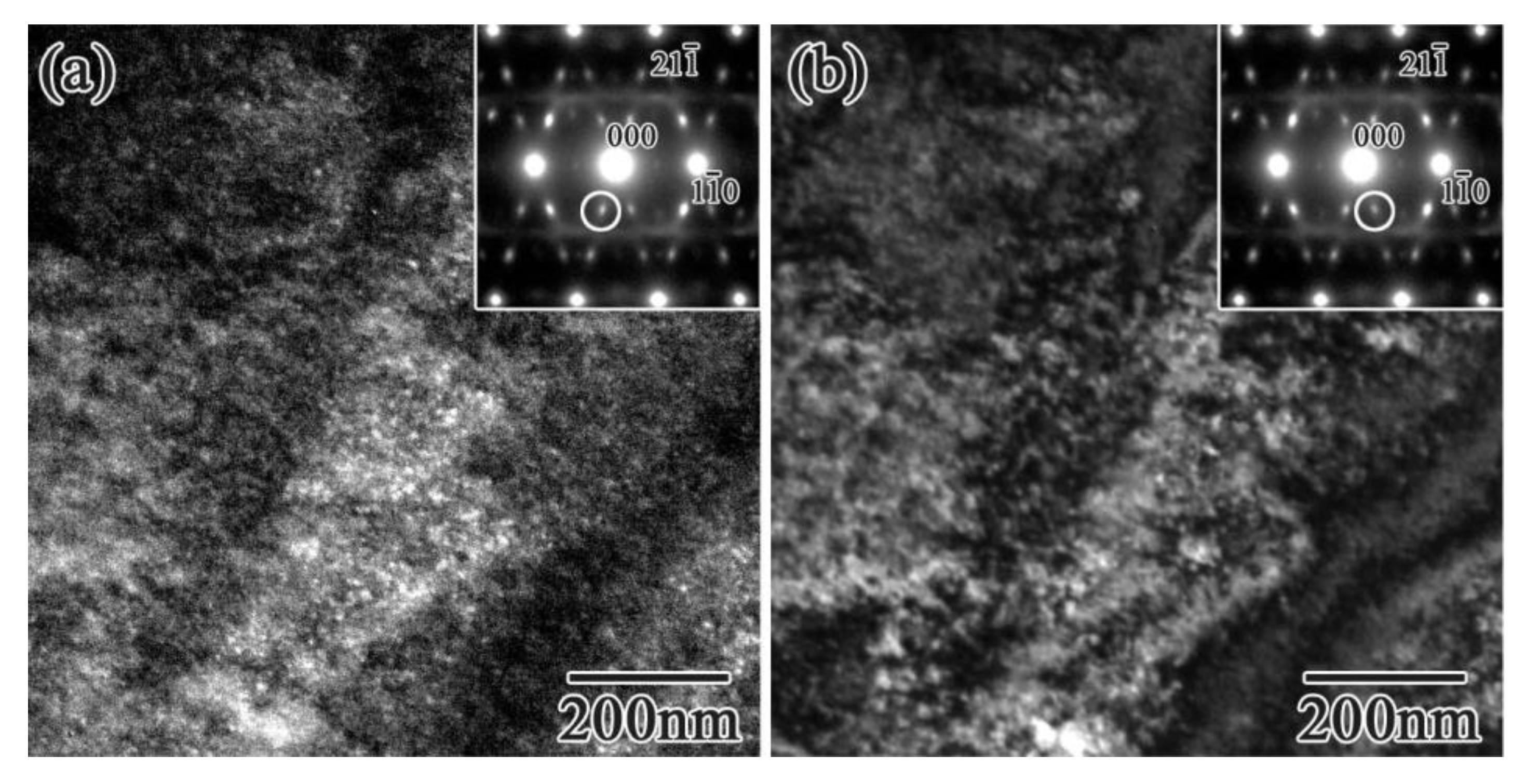
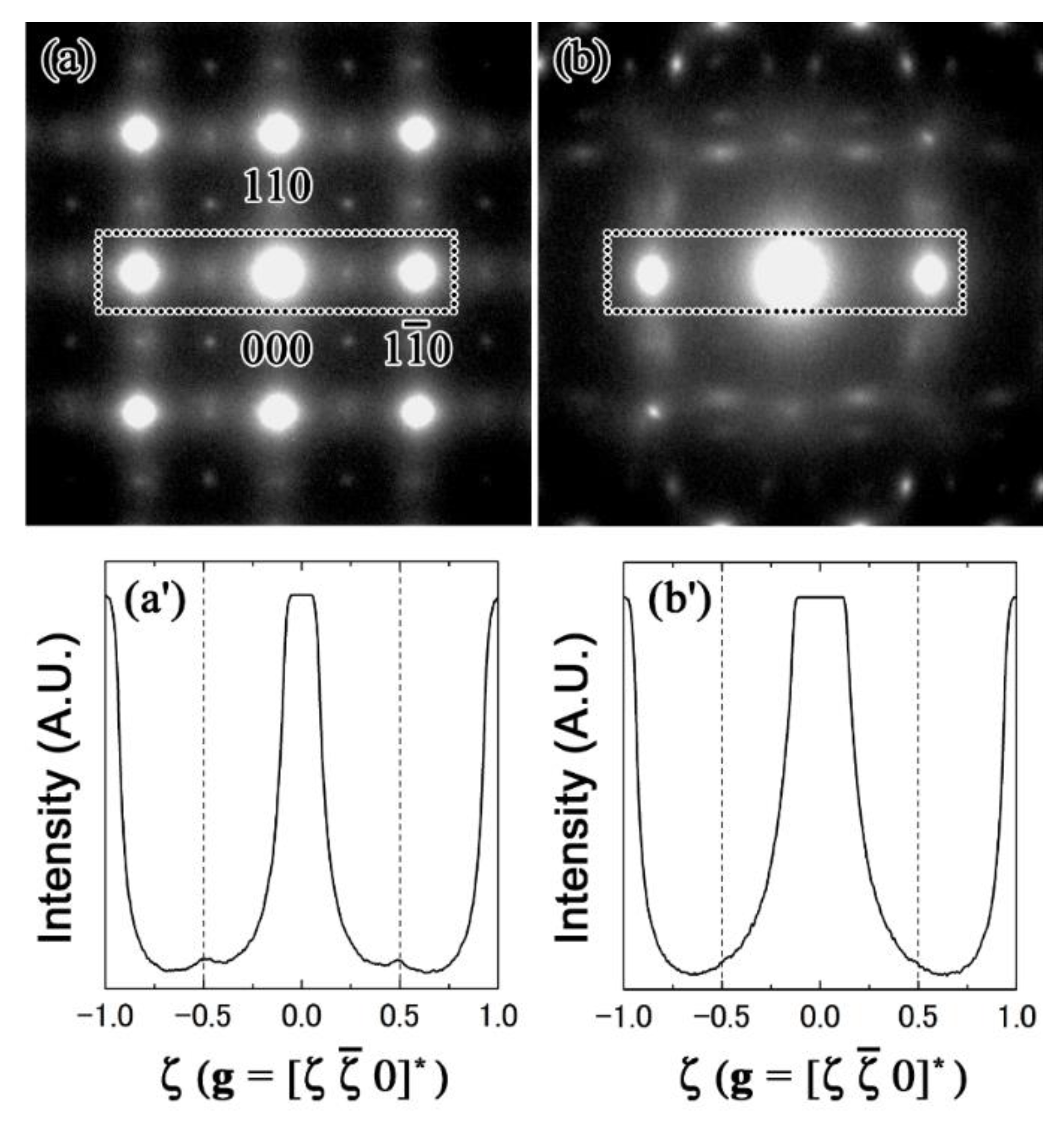


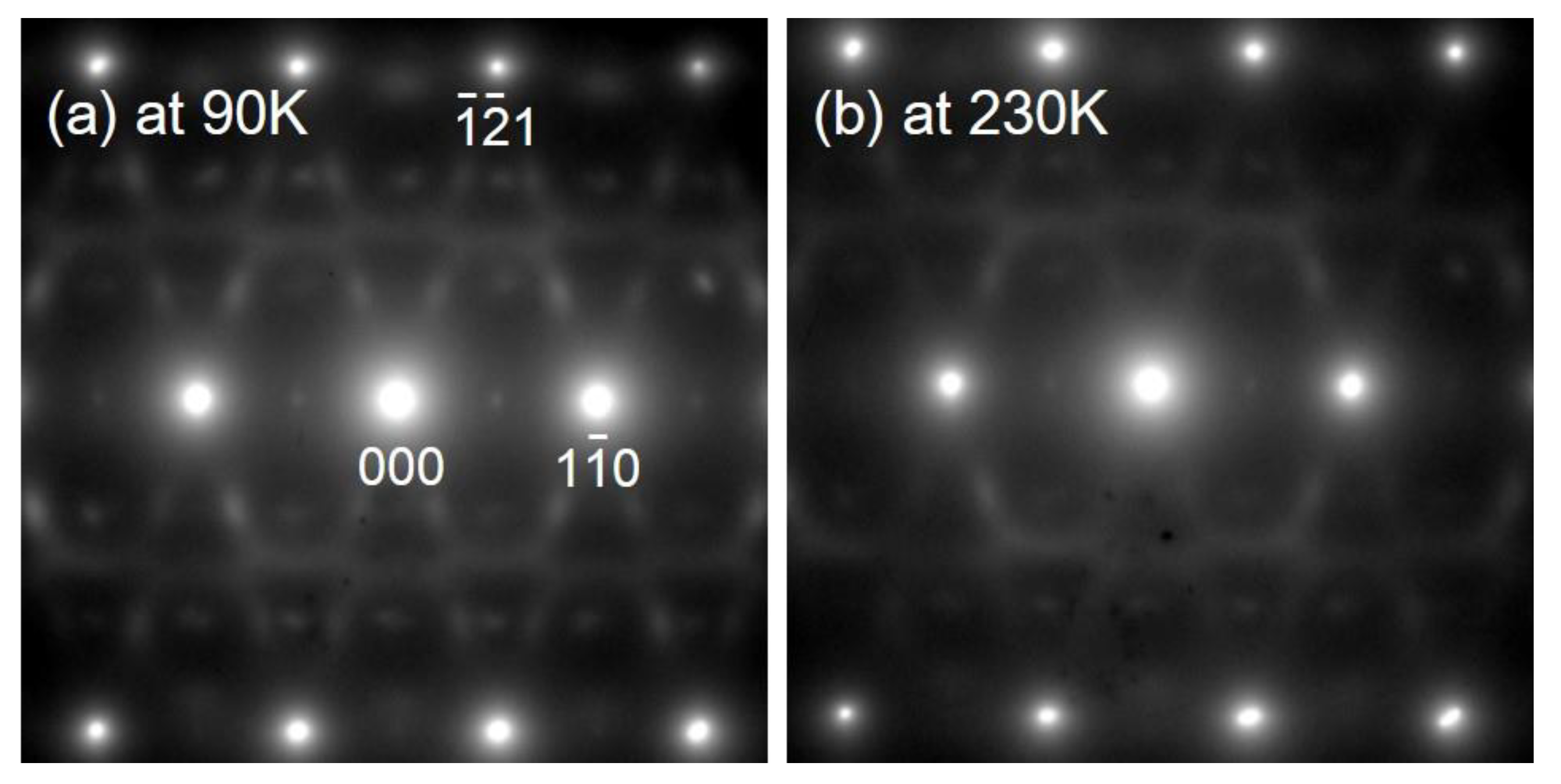
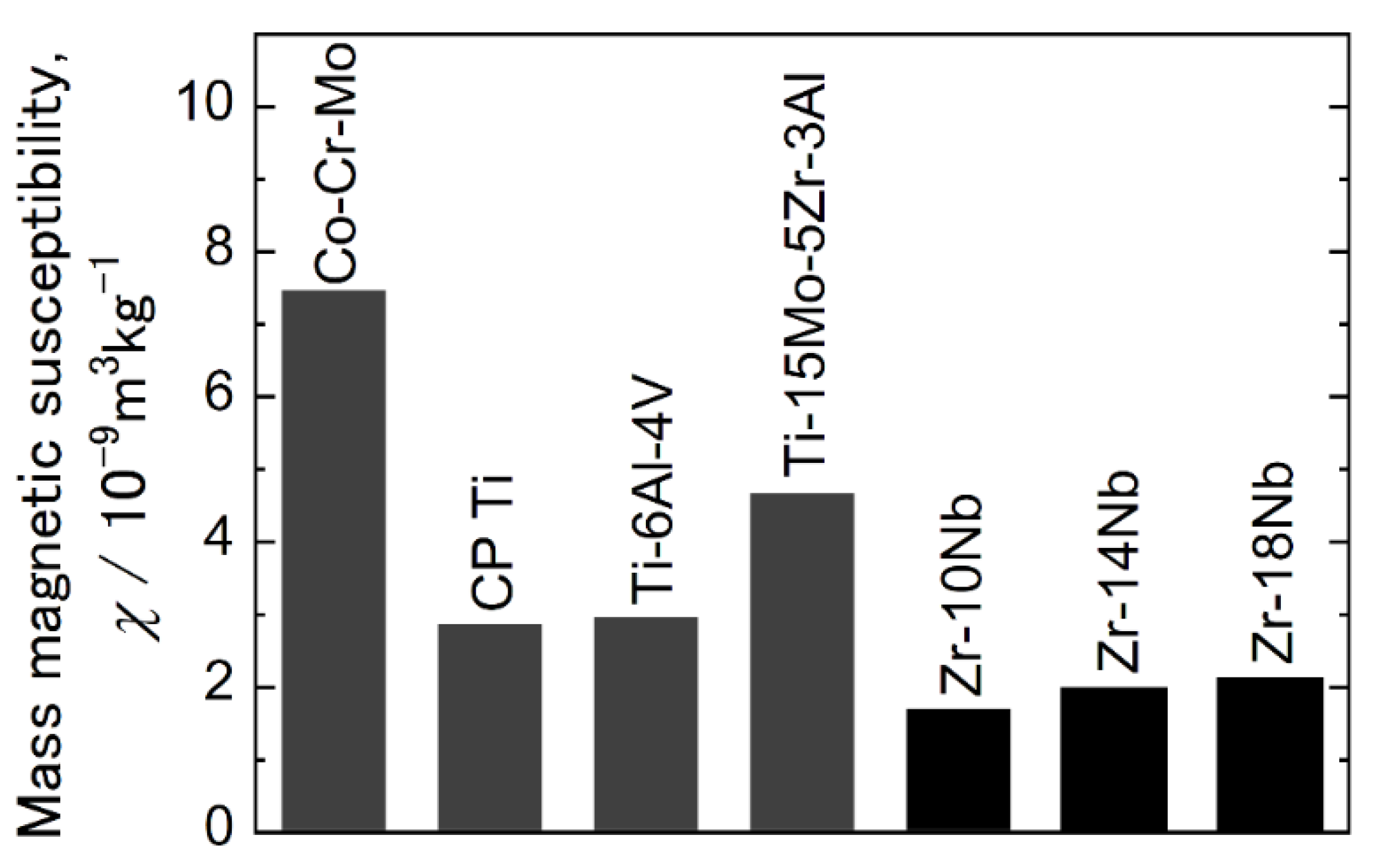
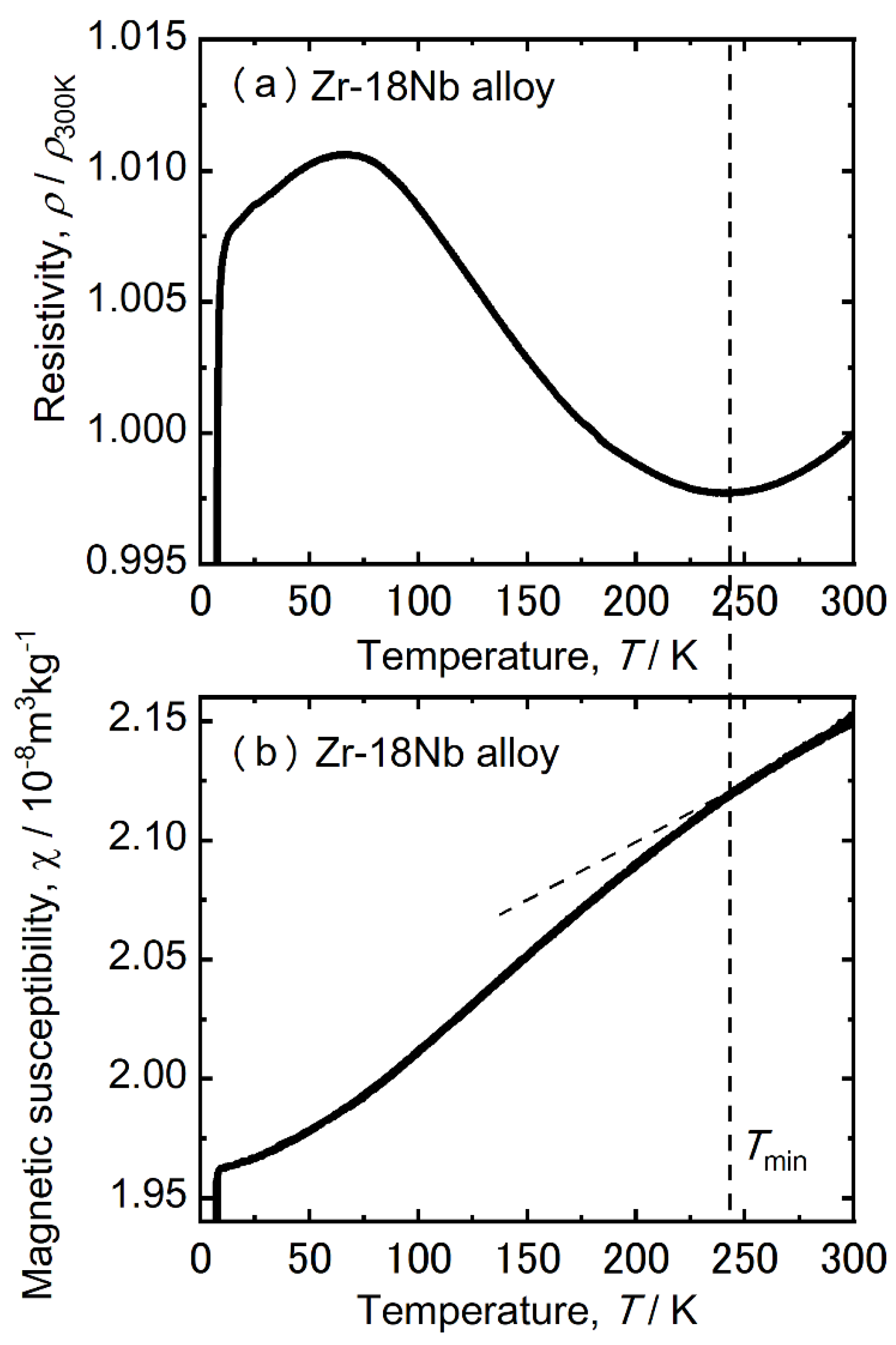
| Nomial Composition | Chemical Composition (at.%) | |
|---|---|---|
| Zr | Nb | |
| Zr-10at.%Nb | Bal. | 9.88 |
| Zr-12at.%Nb | Bal. | 12.12 |
| Zr-14at.%Nb | Bal. | 13.54 |
| Zr-18at.%Nb | Bal. | 17.88 |
| Direction of R | Zone Axis // [113] | Zone Axis // [001] | Zone Axis // [110] |
|---|---|---|---|
| [001] | Present | Absent | Present |
| [110] | Present | Present | Absent |
| [111] | Present | Present | Present |
Publisher’s Note: MDPI stays neutral with regard to jurisdictional claims in published maps and institutional affiliations. |
© 2022 by the authors. Licensee MDPI, Basel, Switzerland. This article is an open access article distributed under the terms and conditions of the Creative Commons Attribution (CC BY) license (https://creativecommons.org/licenses/by/4.0/).
Share and Cite
Todai, M.; Fukunaga, K.; Nakano, T. Athermal ω Phase and Lattice Modulation in Binary Zr-Nb Alloys. Materials 2022, 15, 2318. https://doi.org/10.3390/ma15062318
Todai M, Fukunaga K, Nakano T. Athermal ω Phase and Lattice Modulation in Binary Zr-Nb Alloys. Materials. 2022; 15(6):2318. https://doi.org/10.3390/ma15062318
Chicago/Turabian StyleTodai, Mitsuharu, Keisuke Fukunaga, and Takayoshi Nakano. 2022. "Athermal ω Phase and Lattice Modulation in Binary Zr-Nb Alloys" Materials 15, no. 6: 2318. https://doi.org/10.3390/ma15062318
APA StyleTodai, M., Fukunaga, K., & Nakano, T. (2022). Athermal ω Phase and Lattice Modulation in Binary Zr-Nb Alloys. Materials, 15(6), 2318. https://doi.org/10.3390/ma15062318







